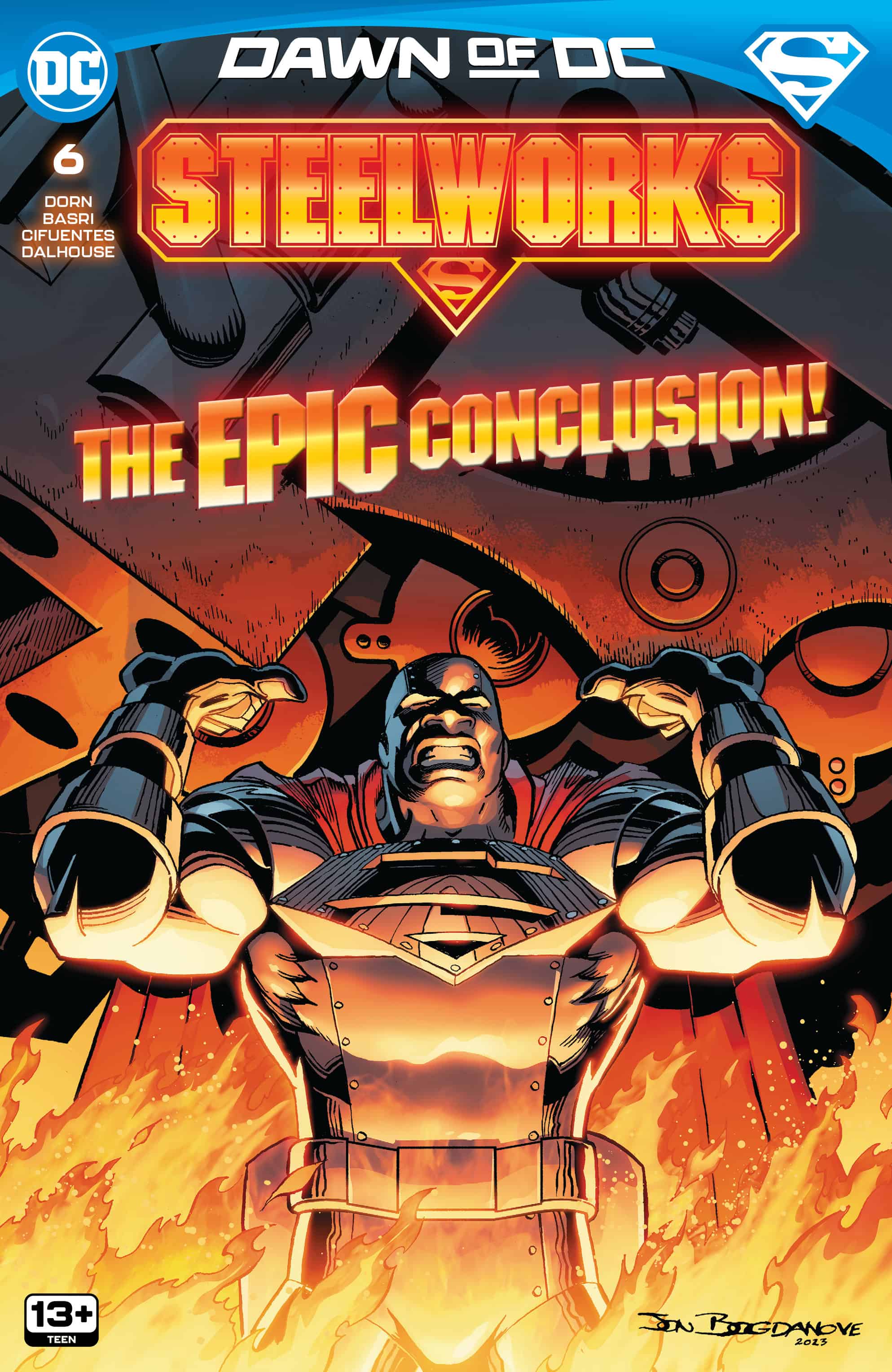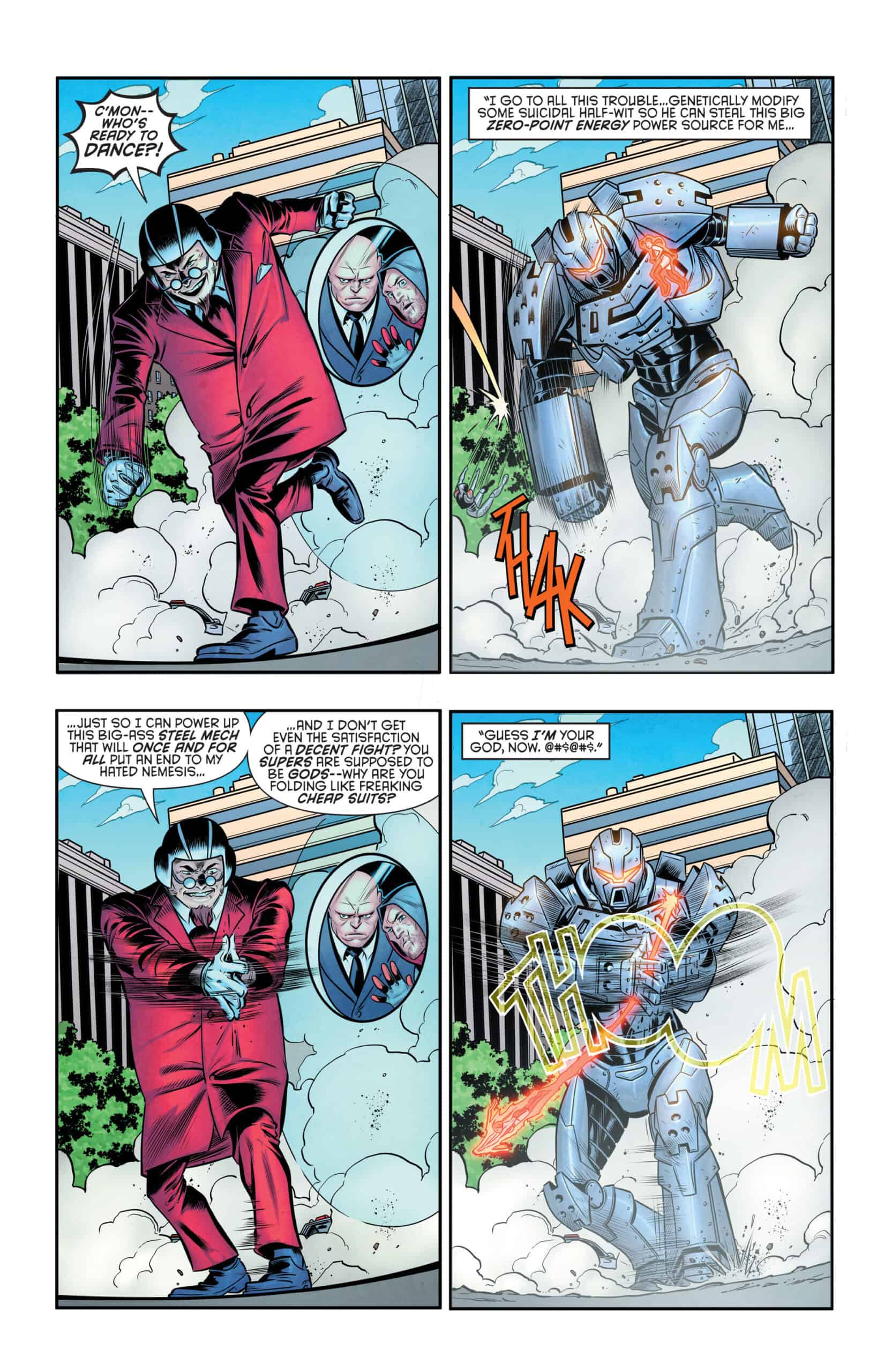Steelworks #6

Recap
THE EPIC FINALE! As a massive mecha battle rages across Metropolis between John Henry Irons and his fierce rival Charles Walker III, the ultimate sacrifice is made to ensure Metropolis's clean- energy future will live on! Life, death, and a new tomorrow are all in play in this final chapter of Michael Dorn and Sami Basri's Steelworks saga!
Review
Steelworks #6 brings a complicated and occasionally thought provoking series to an end. Though sometimes inconsistent, the series’ first five issues successfully told a multi-layered story. Unfortunately the same cannot be said for the series’ final issue.
Charles Walker’s giant robot, powered by John Henry’s zero point energy sphere, is terrorizing Metropolis when Steelworks #6 opens. Most of the Supers are unable to fight back because of the Genesis Radiation the sphere emits. But seeing Walker go crazy not just in getting revenge against John Henry but in attacking the city as a whole makes Kerry (Silver Mist) realize that he’s on the wrong side. He joins John Henry’s forces in the middle of the battle and tries to recover the ZPE sphere and shut down the robot at the cost of his own life. But even with Kerry’s help, the Supers have their work cut out for them.
Steelworks #6 squanders the story and character complexity the series built up by taking the easy way out on every storythread. The resolution of the zero point energy thread isn’t really surprising. It was predictable from the start that, one way or another, zero point energy wasn’t going to survive the series. Free, unlimited energy is too big of a game changer to have running around the DC universe, so Superman chucks the ZPE sphere into the sun. John Henry then speaks to how humanity isn’t ready, he won’t be another “death, destroyer of worlds,” and he’ll go back to the drawing board to do it right. Invoking that particular phrase, associated with J. Robert Oppenheimer and by extension the creation of the atomic bomb, gives Dorn a narrative Get Out of Jail Free card. These accidental negative side effects of technology meant to uplift humanity aren’t comparable to the devastating results of the intentional creation of the worst weapon humanity had ever seen. But likening the one to the other is an easy way to put that plot point to rest without any serious discussion.
The way Dorn handles Kerry is even more cowardly. The previous issue gave Kerry’s revenge a surprising motivation–it wasn’t just about Amertek laying him off, but also about Steel’s interference in Kerry’s misguided attempt to “accidentally” kill himself so his ailing wife could collect the lie insurance. Steelworks #6 all but throws that development out the window, tying Kerry’s animosity toward John Henry solely back to the failure of Amertek. Kerry doesn’t bring up their encounter in the street. Nor does John Henry despite remembering Kerry all the way back to their days at Amertek. This interaction is very surface level, and it reduces Kerry, a well-realized three-dimensional character, into little more than a henchman with a change of heart.
Still worse is how the series dispenses with Kerry. Rather than examine the shades of gray behind his actions, Dorn metes out the same fate that befalls so many bad guys who switch sides: he kills Kerry. And he does so not just without remark, but with conscious dismissal as the Supers are depicted ignoring his corpse which is in the same panel as they are when they come upon the sphere. It’s a cheap way to avoid the moral complexity of Kerry’s actions and John Henry’s connection to him.
Unfortunately Basri and Cifuentes don’t elevate Steelworks #6’s shortcomings. Conveying emotions via facial expression has been a strength throughout the series, but there isn’t enough of that here to fill in the emotional gaps. Just as Dorn doesn’t write in an emotional conflict between Kerry and John Henry when they finally meet, so too is there no complex emotion on display visually. Indeed, John Henry looks bored.
The issue’s most intense emotion is reserved for Charles Walker who comes off as crazed to the point of over exaggeration.
Basri and Cifuentes succeed mainly in the action sequences. The shading and linework they apply to Walker’s giant robot almost distort its movement, creating the sensation of speed and power. This same speed and power is ultimately turned around when the Supers fight back. Rather than emanating from the robot, the visual effects are drawn on top of the robot; it looks overwhelmed as a result.
Dalhouse doesn’t hold back during the action sequences where his work stands out the most. Explosions of red and orange emphasize Lana’s overcharged power as she fights Walker’s robot alone. Dalhouse uses similar colors when John Henry fights back. It’s not subtle, but it’s effective in further reinforcing Basri and Cifuentes’ work.
Leigh largely color coordinates the sound effects during the issue’s action sequences. This works very well in some cases, but in others the sound effects almost fade into the background. Overall, though, it’s an effective choice.
Final Thoughts
Steelworks began with a great deal of promise. Dorn introduced complex themes and fully developed most of the characters in relation to the story. The series stumbled at times, but stayed largely consistent through five issues. Unfortunately Steelworks #6 doesn’t fulfill that early promise as the final issue lands with a bit of a thud.
Steelworks #6: Too Simple A Finale
- Writing - 5/105/10
- Storyline - 6/106/10
- Art - 8/108/10
- Color - 8/108/10
- Cover Art - 9/109/10





